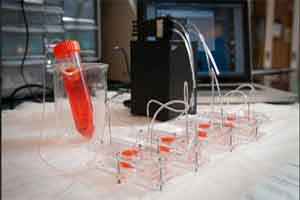- Home
- Editorial
- News
- Practice Guidelines
- Anesthesiology Guidelines
- Cancer Guidelines
- Cardiac Sciences Guidelines
- Critical Care Guidelines
- Dentistry Guidelines
- Dermatology Guidelines
- Diabetes and Endo Guidelines
- Diagnostics Guidelines
- ENT Guidelines
- Featured Practice Guidelines
- Gastroenterology Guidelines
- Geriatrics Guidelines
- Medicine Guidelines
- Nephrology Guidelines
- Neurosciences Guidelines
- Obs and Gynae Guidelines
- Ophthalmology Guidelines
- Orthopaedics Guidelines
- Paediatrics Guidelines
- Psychiatry Guidelines
- Pulmonology Guidelines
- Radiology Guidelines
- Surgery Guidelines
- Urology Guidelines
New 'body-on-a-chip' for quick drug testing developed

Scientists have created micro hearts, lungs and livers that be combined to develop a "body- on-a-chip" and mimic how the human body responds to new medications.
Drug compounds are currently screened in the lab using human cells and then tested in animals. However, neither of the methods adequately replicates how drugs affect human organs.
"There is an urgent need for improved systems to accurately predict the effects of drugs, chemicals and biological agents on the human body," said Anthony Atala, from Wake Forest Institute for Regenerative Medicine in the US.
Researchers developed micro-sized 3D organs, known as organoids, and connected them together on a single platform to monitor their function.
While other teams have combined cells from multiple organs in a similar system, this is the first reported success using 3D organ structures, known to be higher functioning and to more accurately model the human body.
The organ structures were made from cell types found in native human tissue using 3D printing and other methods.
Heart and livers were selected for the system because toxicity to these organs is a major reason for drug candidate failures and drug recalls.
Lungs are the point of entry for toxic particles and also for aerosol drugs, such as asthma inhalers.
The organoids are placed in a sealed, monitored system - complete with real-time camera. A nutrient-filled liquid that circulates through the system keeps the organoids alive and is used to introduce potential drug therapies into the system.
The researchers first tested the organoids to ensure their similarity to human organs. For example, the micro-liver received a high dose of a common pain reliever - and then a different drug to counteract the toxic effects.
"The data shows a significant toxic response to the drug as well as mitigation by the treatment, accurately reflecting the responses seen in human patients," said Aleksander Skardal, assistant professor at Wake Forest Institute for Regenerative Medicine.
However, more important than how an individual organ responds to drugs is how the body as a whole responds.
In many cases during testing of new drug candidates - and sometimes even after the drugs have been approved for use - drugs have unexpected toxic effects in tissues not directly targeted by the drugs themselves.
"If you screen a drug in livers only, for example, you're never going to see a potential side effect to other organs," said Skardal.
"By using a multi-tissue organ-on-a-chip system, you can hopefully identify toxic side effects early in the drug development process, which could save lives as well as millions of dollars," he said.
The scientists conducted multiple scenarios to ensure that the body-on-a-chip system mimics a multi-organ response.
For example, they introduced a drug used to treat cancer into the system. Known to cause scarring of the lungs, the drug also unexpectedly affected the system's heart. However, a control experiment using only the heart showed no response.
"This was completely unexpected, but it's the type of side effect that can be discovered with this system in the drug development pipeline," Skardal said.

Disclaimer: This site is primarily intended for healthcare professionals. Any content/information on this website does not replace the advice of medical and/or health professionals and should not be construed as medical/diagnostic advice/endorsement or prescription. Use of this site is subject to our terms of use, privacy policy, advertisement policy. © 2020 Minerva Medical Treatment Pvt Ltd